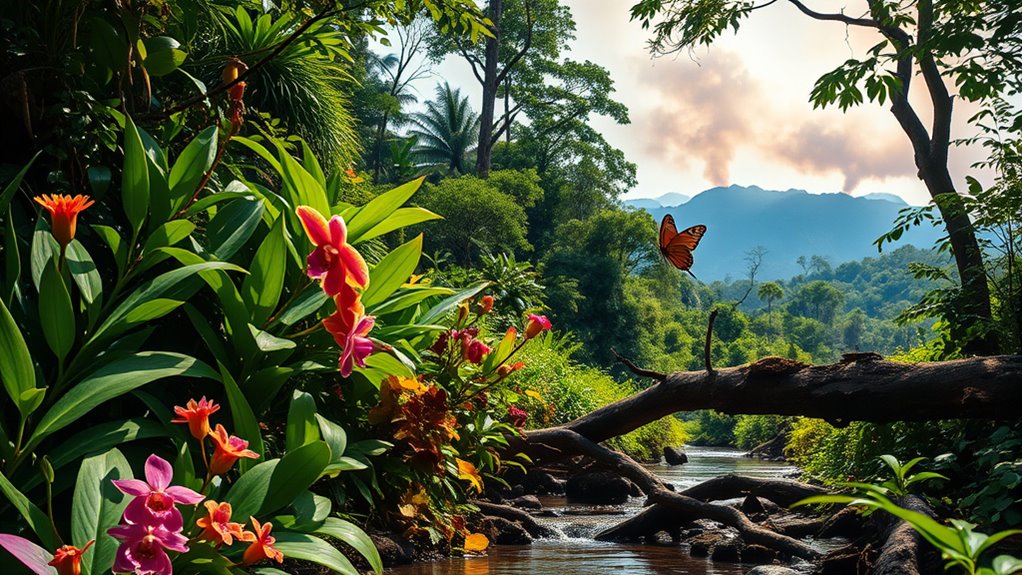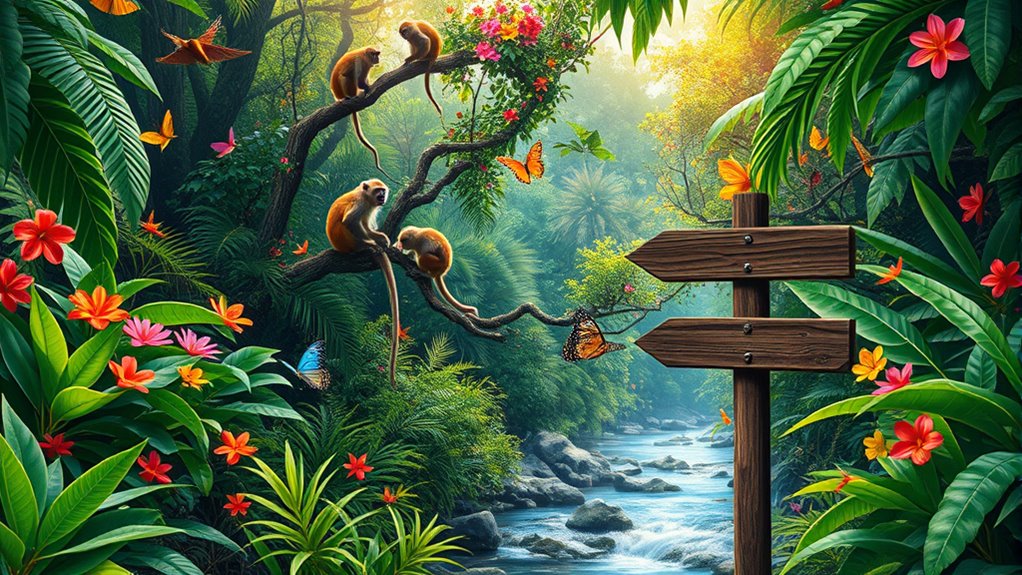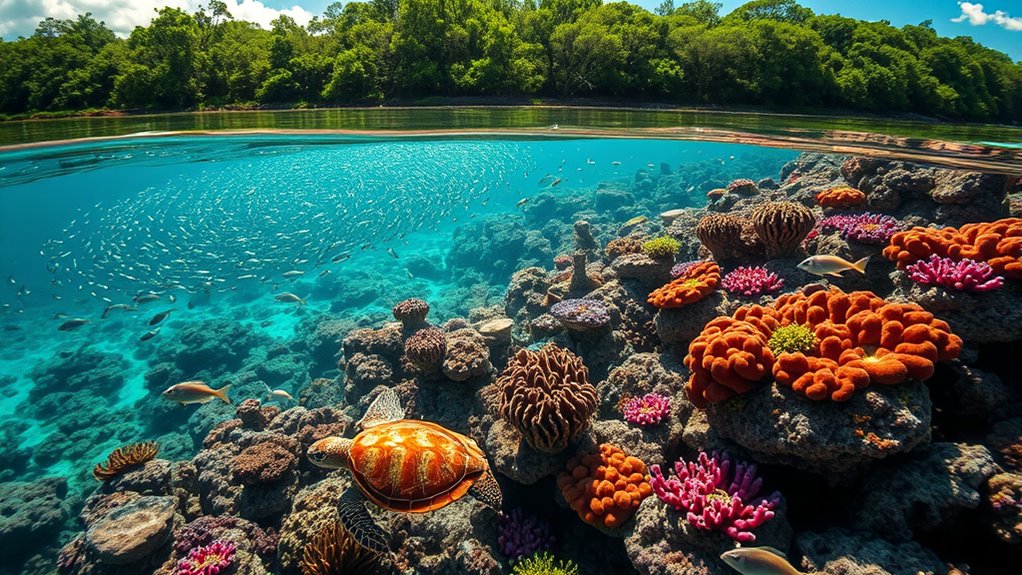Biodiversity matters because it supports healthy ecosystems that provide food, clean water, and climate stability. It includes the variety of life on Earth, from genes to ecosystems, helping species adapt and thrive. But threats like climate change, pollution, and habitat loss are pushing many species to the brink. Protecting biodiversity involves community involvement and sustainable practices. By understanding its importance and solutions, you can contribute to preserving our planet’s rich diversity for future generations. There’s much more to explore!
Key Takeaways
- Biodiversity ensures ecosystem stability, resilience, and the ability to adapt to environmental changes, which is crucial for human survival.
- Protecting biodiversity supports food production, enhances nutritional value, and provides economic benefits through sustainable practices like eco-tourism.
- Current threats such as climate change, habitat loss, and pollution highlight the urgent need for conservation efforts to prevent species extinction.
- Community involvement and traditional knowledge are essential for successful conservation strategies, fostering local ownership and sustainable resource management.
- Establishing protected areas and supporting habitat restoration are effective strategies to safeguard critical ecosystems and promote biodiversity preservation.
Understanding Biodiversity

Biodiversity, the rich tapestry of life on Earth, encompasses the variety of genetic, species, and ecosystem diversity.
You’ll find that genetic diversity allows species to adapt to environmental changes, ensuring their survival. Species diversity refers to the number and relative abundance of different species in an ecosystem, while ecosystem diversity includes various habitats like forests, wetlands, and coral reefs. Additionally, the estimated number of species on Earth includes approximately 8.7 million terrestrial species, highlighting the vastness of biodiversity. Healthy ecosystems provide essential services such as clean air and water purification, which are vital for human well-being. Coastal zones, for example, are critical habitats that support marine life, contributing to both biodiversity and the health of our oceans. Research indicates that proper habitat care is essential for sustaining these vital ecosystems.
You’ll notice that tropical regions, particularly rainforests and coral reefs, boast the highest levels of biodiversity. This abundance enriches our planet and plays a crucial role in maintaining ecological balance.
Understanding these levels and distributions of biodiversity helps you appreciate the intricate connections that sustain life, highlighting the importance of preserving our natural world for future generations.
The Role of Biodiversity in Ecosystem Health

While you may not always realize it, the health of ecosystems hinges on the rich diversity of life they contain. Biodiversity serves as the foundation of ecosystem stability, allowing natural systems to adapt to changes and disturbances. Diverse ecosystems act as barriers against pests and diseases, ensuring a balanced environment that supports essential services like pollination and water purification. When biodiversity thrives, food production becomes more resilient and nutritious. High-diversity communities can better withstand environmental stressors, enhancing ecological resilience. This balance is crucial not only for nature but also for human health and well-being. Additionally, sustainable harvesting practices can help maintain the balance of biodiversity by ensuring that resource use does not compromise ecosystem integrity. Furthermore, the decline in global animal populations underscores the importance of conserving biodiversity for maintaining ecosystem health. Additionally, diverse ecosystems contribute to renewable energy innovations, which can enhance sustainability and support ecological balance. The integration of renewable energy sources into ecosystem management can further promote biodiversity by reducing reliance on fossil fuels and mitigating climate change impacts.
Cultural Significance of Biodiversity

Why should you care about the cultural significance of biodiversity? It’s crucial because traditional practices, like sacred groves in India, effectively conserve biodiversity while honoring cultural values.
Indigenous knowledge systems play a vital role in tackling environmental challenges, ensuring sustainable resource management. Communities, such as the Bishnoi and the Apatani, demonstrate that cultural heritage can lead to successful conservation efforts. Traditional Ecological Knowledge offers insights that modern science is exploring, further enhancing the effectiveness of these efforts. Furthermore, the combination of genetic predisposition and cultural practices can lead to innovative solutions for preserving biodiversity. Additionally, the integration of diversification strategies in resource management can bolster both cultural and ecological resilience. Understanding the key domains of development can also inform how cultural practices evolve to support biodiversity over time.
When you recognize the interconnectedness of culture and nature, you see how practices enrich biodiversity. Integrating cultural values into conservation strategies not only fosters local support but also enhances ecological resilience.
Current Threats to Biodiversity

Cultural practices can enrich biodiversity, but they face significant threats today.
Climate change accelerates species extinction as many can’t adapt to rapid shifts. Rising sea levels and extreme weather events further disrupt ecosystems, threatening coastal habitats and altering migratory patterns. This rapid rate of extinction is unprecedented in human history.
Pollution compounds these issues; air and water contaminants harm species and degrade ecosystems.
Habitat loss due to urbanization and agricultural expansion is staggering, with two football fields disappearing every minute.
Overexploitation of species, like overfishing and deforestation, pushes many to the brink of extinction. Nearly a fifth of endangered species face risks from unsustainable practices.
It’s crucial to recognize these threats and take action to protect our planet’s rich biodiversity before it’s too late.
Major Causes of Biodiversity Loss

As human activities continue to reshape the planet, the major causes of biodiversity loss become increasingly evident. Deforestation for agriculture and urbanization destroys habitats, while intensive farming practices limit genetic diversity. Coastal development also harms marine life, and infrastructure expansion fragments ecosystems, making it hard for species to connect. Overexploitation of resources, like overfishing and overhunting, further threatens wildlife, leading to population declines. Logging and mining disrupt ecosystems, reducing biodiversity in affected areas. Invasive species, often introduced by human actions, outcompete native species, causing additional harm. Each of these factors compounds the crisis, making it urgent for you to understand and address these challenges in your efforts to protect our planet’s precious biodiversity. Notably, the current species loss rate is estimated to be between 100 and 10,000 times the background extinction rate, highlighting the severity of the situation. Furthermore, divorce law in the Philippines serves as a reminder of how societal structures can influence personal and environmental wellbeing. Moreover, understanding the importance of art theory can enhance our appreciation for the intricate relationships within ecosystems. Additionally, investing in renewable energy technologies can help mitigate some of the human impacts that drive biodiversity loss.
The Importance of Biodiversity Surveys

Understanding the threats to biodiversity is just the beginning; addressing these challenges requires effective strategies. Biodiversity surveys play a crucial role in project management by assessing risks early, helping you prioritize mitigation efforts and minimize impacts. They provide site-specific data, ensuring your projects are designed to reduce biological risks effectively. Robust survey data enhances communication with stakeholders, aligning expectations and identifying mitigation opportunities. Furthermore, these surveys make projects bankable by offering objective, data-based approaches to environmental impact assessments. Engaging in biodiversity surveys not only supports local wildlife populations but also fosters community involvement and education. By focusing on community resilience, such efforts can significantly bolster the effectiveness of conservation measures. Additionally, incorporating high-fiber foods like chia seeds into community diets can improve overall health and support local ecosystems. Larger plants, like the Areca Palm, can also enhance biodiversity by improving indoor air quality and providing habitats for various species.
Strategies for Biodiversity Conservation

While biodiversity faces numerous threats, implementing effective conservation strategies can help protect ecosystems and species.
Establishing protected areas and reserves, like national parks and wildlife refuges, safeguards critical habitats. You can also support habitat restoration efforts, which reintroduce native species and enhance ecosystem health. Engaging in mindfulness practices can also help you stay focused on the importance of biodiversity. Additionally, understanding the significance of advance directives in planning for the future can ensure that conservation efforts are sustained over time. Incorporating solar energy solutions into conservation initiatives can reduce reliance on fossil fuels and promote eco-friendly practices.
Involving local communities in conservation promotes sustainable livelihoods and responsible resource management. Designating vegetation protection areas prevents development in vital habitats, while habitat connectivity plans enable species migration and genetic diversity. Protected Areas and Reserves serve as benchmarks for ecological research and monitoring, ensuring informed decisions that benefit both people and the environment.
Additionally, consider participating in species recovery programs and managing invasive species to protect native populations. By adopting sustainable agriculture and forestry practices, you can minimize resource overuse and contribute to ecosystem balance. Every action counts in the fight for biodiversity conservation.
The Impact of Climate Change on Biodiversity

Climate change significantly impacts biodiversity, reshaping ecosystems and threatening species’ survival. Rising global temperatures alter habitats, pushing many species to move northward or to cooler elevations. Sound healing has been shown to promote emotional well-being, which can be vital for communities affected by ecological disruptions. The Forex market’s fluctuations can also impact the economies of regions reliant on biodiversity, influencing conservation funding. Additionally, the increasing frequency of extreme weather events can exacerbate existing vulnerabilities in ecosystems, leading to more pronounced effects on biodiversity.
Extreme weather events, like droughts and storms, disrupt ecosystems, leading to accelerated extinction rates and threatening around 25% of assessed species. Marine life is also affected, with species shifting poleward due to changing ocean conditions and acidification hindering shell formation.
These disruptions change how species interact within ecosystems, destabilizing the delicate balance of nature. Invasive species thrive in warmer climates, further complicating the situation. Increased intensity and frequency of fires threaten many habitats, further exacerbating the challenges faced by vulnerable species.
As you witness these changes, it’s crucial to understand that protecting biodiversity is vital for maintaining ecosystem integrity and resilience against climate change.
Community Involvement in Biodiversity Protection

Community involvement is crucial for biodiversity protection because it taps into local knowledge and fosters a sense of ownership over natural resources. When you engage your community in conservation efforts, you enhance strategies that benefit everyone. Sustainable living practices can further amplify these community-driven initiatives, ensuring that they are both effective and inclusive. Additionally, smart shopping strategies can help communities obtain necessary resources while minimizing environmental impact.
Grassroots initiatives often see higher success rates due to local support, and indigenous knowledge can address pressing environmental issues effectively. Establishing trust through transparent communication is vital, as is involving community members in planning and decision-making. Active participation of community members in conservation measures can significantly enhance the effectiveness of these initiatives.
Offering economic benefits, like eco-tourism, aligns community interests with conservation. By respecting cultural values and providing capacity-building programs, you empower your community to take action.
Ultimately, your participation not only boosts biodiversity but also strengthens community unity and ensures sustainability for future generations.
Future Directions for Biodiversity Preservation

As the urgency for biodiversity preservation grows, it’s essential to explore innovative strategies that leverage technology and community engagement. You can harness artificial intelligence and remote sensing to monitor ecosystems effectively, helping you detect changes in real-time. Integrating big data with conservation efforts allows you to develop targeted strategies that address specific threats. Recent advancements in AI-driven cameras enable precise monitoring of wildlife populations and habitats, further enhancing conservation efforts. Embrace genetic technologies, like CRISPR-Cas9, to boost species resilience against climate change and diseases. Additionally, engage in habitat restoration and species reintroduction to stabilize ecosystems. Collaborate with indigenous peoples to incorporate traditional knowledge, and advocate for international frameworks like the Kunming-Montreal Global Biodiversity Framework.
Frequently Asked Questions
How Can Individuals Contribute to Biodiversity Conservation Efforts?
You can contribute to biodiversity conservation efforts in several ways.
Start by supporting local farmers and buying organic produce to promote diverse agricultural practices.
Plant native species in your garden to enhance local ecosystems.
Reduce your meat consumption to lessen the strain on land resources.
Get involved in community clean-up events and advocate for sustainable practices in your community.
Every small action you take can help protect the intricate web of life around you.
What Role Do Zoos Play in Biodiversity Protection?
Did you know that zoos contribute nearly $350 million annually to global conservation efforts?
You play a crucial role in biodiversity protection when you visit zoos. They engage in breeding programs that support endangered species and conduct research to improve animal care.
Are There Economic Benefits to Preserving Biodiversity?
Absolutely, there are significant economic benefits to preserving biodiversity.
By maintaining diverse ecosystems, you ensure essential services like pollination and water purification, which are crucial for industries like agriculture.
You’ll find that investing in biodiversity can enhance your brand reputation, leading to increased customer loyalty and market opportunities.
Plus, it reduces regulatory risks and helps manage supply chain disruptions, ultimately contributing to a more resilient and profitable business environment.
How Does Biodiversity Affect Human Health Directly?
Biodiversity affects your health in several direct ways. It ensures you have access to nutritious food and medicinal resources, vital for overall well-being.
Diverse ecosystems help regulate diseases, keeping infections at bay and maintaining clean air and water, which are essential for your health.
Additionally, exposure to rich natural environments can boost your mental health, offering recreational opportunities and enhancing your quality of life in ways you mightn’t even realize.
What Local Actions Can Communities Take to Support Biodiversity?
You can support biodiversity in your community by organizing local events like tree planting days or species counting exercises.
Host workshops to educate others on sustainable gardening practices and collaborate with local authorities on creating green spaces.
Establish volunteer groups to monitor wildlife and develop educational programs in schools.
Conclusion
In a world where biodiversity is rapidly declining, it’s crucial to recognize its importance in maintaining ecosystem health and cultural richness. What can you do to protect the diverse life forms that sustain our planet? By supporting conservation efforts, getting involved in your community, and advocating for sustainable practices, you can make a difference. Together, we can ensure that future generations inherit a vibrant, thriving planet filled with the wonders of biodiversity.









